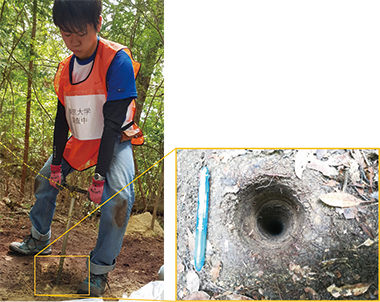Disclaimer: machine translated by DeepL which may contain errors.
~ Message from a graduate student~.
Is it actually in Japan?
"Rare Earths"
 |
| Makoto Nagasawa |
| Makoto Nagasawa |
| (First-year doctoral student, Department of Earth and Planetary Science) |
Science and technology have made human beings fundamentally different from other species as living organisms on the Earth, and are even enabling transcendence of time and space (anytime, anywhere). It is no exaggeration to say that natural resources necessary for the construction of all social infrastructures have been responsible for this development. Therefore, numerous resource problems (oligopoly and depletion) have arisen, and today, environmental problems such as global warming are becoming even more serious. As a nature lover since childhood, I have felt a sense of crisis about these problems and am currently researching resources of rare earth elements (REEs) (see note) in the Department of Earth and Planetary Science.
REEs are also called "vitamins of industry" and are important elements that support the development of high-tech industries. For example, REEs such as neodymium and dysprosium are used in motor magnets for manufacturing smartphones and PCs, which are indispensable for our daily lives, wind power generation and electric vehicles, for which further demand is expected in the future. Ion ore" is one of the REE resources produced by weathering of rocks, and is attracting attention economically and environmentally because (i) it is rich in economically valuable heavy REEs, (ii) REEs can be easily extracted with dilute electrolyte solutions, and (iii) no radioactive elements are leached in the process. However, ionite is currently developed only in southern China, and its ubiquity has a political dimension, as evidenced by the 2010 REE embargo against Japan triggered by the Senkaku Islands issue. Since the main factors controlling the formation of ionic ores are the source rock (e.g., granite with high REE content) and the degree of weathering (dependent on average temperature and precipitation), my study predicts the existence of ionic ores in Japan, which is located in a climatic zone similar to that of southern China and where granite is abundant.
Against this background, I am attempting to elucidate the REE concentration mechanism in ionic ores and their host minerals at the atomic and molecular level with a view to exploring ionic ores in Japan. Although there seems to be a gap between the macro-scale activities of resource exploration and the exploration of micro-scale structures, they are in fact closely related. For example, if the host mineral that adsorbs REEs is known, then candidate exploration sites can be narrowed down based on the conditions under which the mineral exists. Furthermore, if we know where and in what state REEs are adsorbed in the host minerals, we can optimize the conditions for REE extraction (solution type, concentration, etc.) based on this information, which may even lead to improved smelting methods.
 |
(Note) A generic name for 17 elements consisting of scandium, yttrium, and 15 lanthanide elements (lanthanum to lutetium). Lanthanum to europium is called light REE, and scandium, yttrium, gadolinium, and lutetium are called heavy REE. |
|
| (Left) Drilling core sample collection. The core was drilled 8 m by hand. | ||
Going outside for fieldwork and sampling (see figure) and "dissecting" the collected samples down to the atomic and molecular level is pure fun and interesting. On the other hand, the information obtained has a variety of potential applications and is useful to society. In 21st century society, where cross-disciplinary activities such as industry-academia collaboration and interdisciplinary research are prominent, I feel that the bottom-up approach of science, which holds unlimited possibilities, is becoming increasingly important. We hope that this article will help you to think about the connection between science and society.
Profile
|
Published in Faculty of Science News July 2021


